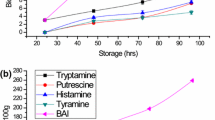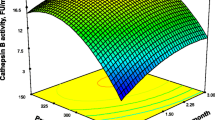Abstract
The effect of bleeding on white muscle quality in amberjack and red sea bream was evaluated by measuring ATP-related compounds, volatile basic nitrogen (VBN), and the trimethylamine (TMA) content. The freshness was evaluated by the K value, and the degree of spoilage was elucidated by VBN and TMA. ATP was rapidly converted to ADP and AMP in the muscle and IMP was the main product of ATP degradation during iced storage. For both species, the IMP content was higher in the muscles of fish that were bled than in those unbled during iced storage. Conversely, the K value and the levels of hypoxanthine (Hx) and VBN were higher in the muscle tissue of unbled fish than in the bled tissue of both species. Similarly, the TMA content was higher in the unbled muscle tissues of both species after a week of storage.




Similar content being viewed by others
References
Mochizuki S, Norita Y, Maeno K (1998) Effects of bleeding on post-mortem changes in the muscle of horse mackerel (in Japanese with English abstract). Nippon Suisan Gakkaishi 64:276–279
Terayama M, Yamanaka H (2000) Effects of bleeding on the quality of skipjack (in Japanese with English abstract). Nippon Suisan Gakkaishi 66:852–858
Terayama M, Ohshima T, Ushio H, Yamanaka H (2002) Effects of instant killing and bleeding machine on quality of spindle-shape fish. Fish Sci 68:1651–1652
Ando M (1996) A study on the mechanism of post-mortem tenderization of fish muscle (in Japanese). Nippon Suisan Gakkaishi 62:555–558
Ando M, Nishiyabu A, Tsukamasa Y, Makinodan Y (1999) Post-mortem softening of fish muscle during chilled storage as affected by bleeding. J Food Sci 64:423–428
Ryder JM (1985) Determination of adenosine triphosphate and its breakdown products in fish muscle by high-performance liquid chromatography. J Agric Food Chem 33:678–680
Saito T, Arai K, Matsuyoshi M (1959) A new method for estimating the freshness of fish. Nippon Suisan Gakkaishi 24:749–750
Conway EJ (1947) Micro-diffusion analysis and volumetric error. Crosby, Lockwood & Son, London
Dyer WJ, Dyer FE, Snow JM (1952) Amines in fish muscle. V. Trimethylamine oxide estimation. J Fish Res Bd Can 8:309–313
Hamada-Sato N, Usui K, Kobayashi T, Imada C, Watanabe E (2005) Quality assurance of raw fish based on HACCP concept. Food Control 16:301–307
Ehira S, Uchiyama H (1974) Freshness-lowering rates of cod and sea bream viewed from changes in bacterial count, total volatile base- and trimethylamine-nitrogen, and ATP related compounds. Nippon Suisan Gakkaishi 40:479–487
Howgate P (2005) Kinetics of degradation of adenosine triphosphate in chill-stored rainbow trout (Oncorhynchus mykiss). Int J Food Sci 40:579–588
Bremner HA, Olley J, Statham JA, Vail AMA (1988) Nucleotide catabolism: Influence on the storage life of tropical species of fish from the north west shelf of Australia. J Food Sci 53:6–11
Fletcher GC, Statham JA (1988) Shelf-life of sterile yellow-eyed mullet (Aldrichetta forsteri) at 4°C. J Food Sci 53:1030–1035
Gill TA (1990) Objective analysis of seafood quality. Food Rev Int 6:681–714
Oehlenschläger J (1992) Evaluation of some well established and some underrated indices for the determination of freshness and/or spoilage of ice stored wet fish. In: Huss HH et al (eds) Quality assurance in the fish industry. Elsevier, Amsterdam, pp 339–350
Ababouch LH, Souibri L, Rhaliby K, Ouahdi O, Battal M, Busta FF (1996) Quality changes in sardines (Sardina pilchardus) stored in ice and at ambient temperature. Food Microbiol 13:123–132
Ringø E, Stenberg E, Strøm AR (1984) Amino acid and lactate catabolism in trimethylamine oxide respiration of Alteromonas putrefaciens NCMB 1735. Appl Environ Microbiol 47:1084–1089
Malle P, Eb P, Tailliez R (1986) Determination of the quality of fish by measuring trimethylamine oxide reduction. Int J Food Microbiol 3:225–235
Gram L, Dalgaard P (2002) Fish spoilage bacteria—problems and solutions. Curr Opin Biotechnol 13:262–266
Uchiyama H, Suzuki T, Ehira S, Noguchi E (1966) Studies on relation between freshness and biochemical changes of fish muscle during ice storage (in Japanese with English abstract). Nippon Suisan Gakkaishi 32:280–285
Acknowledgments
The authors are indebted to Yoshiyuki Kurata for fish preparation.
Author information
Authors and Affiliations
Corresponding author
Rights and permissions
About this article
Cite this article
Ahimbisibwe, J.B., Inoue, K., Shibata, T. et al. Effect of bleeding on the quality of amberjack Seriola dumerili and red sea bream Pagrus major muscle tissues during iced storage. Fish Sci 76, 389–394 (2010). https://doi.org/10.1007/s12562-009-0212-z
Received:
Accepted:
Published:
Issue Date:
DOI: https://doi.org/10.1007/s12562-009-0212-z




